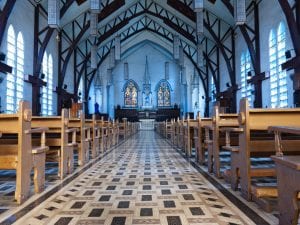Roman Catholic Funeral Service Rituals
Overview of Beliefs and Practices
 “Roman Catholic” refers to the Christian church that recognizes the Pope and Vatican as the authority and representation of God’s teachings. Today, there are about 1.2 billion Roman Catholics around the world.
“Roman Catholic” refers to the Christian church that recognizes the Pope and Vatican as the authority and representation of God’s teachings. Today, there are about 1.2 billion Roman Catholics around the world.
Catholics teach that Jesus died to redeem man from sin. They believe in immortality and that in death a person may be judged to go to Heaven, Hell, or Purgatory. In Purgatory, God’s purifying mercy eventually obtains a place in Heaven for the deceased. Unlike some Protestant beliefs, Roman Catholics are not assured before death that they will go to heaven, and so mourners pray for their deceased loved one’s entrance into heaven. They believe in the body’s eventual resurrection and the body’s reuniting with the soul at Christ’s second coming.
The person’s priest is the first official who should be called upon the death of a Roman Catholic. If the death was expected, the priest may have already attended the person and performed the last rites or final prayers and ministrations preceding death. The next call should be to the funeral home.
Elements of a Catholic Funeral
The most common elements of a Roman Catholic funeral are:
- A vigil service with either the body or cremated remains present. The casket may be either open or closed if the body is present.
- A funeral Mass or service with either the body or cremated remains present. The service is referred to as a Memorial Mass if the body is not present.
- A graveside service with burial of the body or cremated remains or the placing of the remains in a columbarium or mausoleum.
The Vigil (or Wake): A vigil is a prayer ceremony where friends and family gather to pay their respects to the deceased and their family. It may occur at a funeral home, church, family home, or other location. Typical elements include prayers led by a priest or an appropriate layperson. Eulogies, memorials, singing of hymns or secular music, readings, and poems may also be incorporated.
Funeral Mass: The funeral Mass (Memorial Mass if no body is present) is held at the church. At the entrance to the church, the remains are sprinkled with holy water and covered with a pall, a reminder of baptism. When the procession reaches the front of the church, an open bible and a crucifix, symbols of Christian faith, may be placed on the casket. An urn of cremated remains may be carried in procession or placed on a table at the front of the church before the service begins. A flag may be placed on a casket after communion (Source: St. Dominick’s Catholic Church, San Francisco). The Funeral Mass does not typically include eulogies, though loved ones often participate in readings.
While a typical Mass is generally formal and follows traditional elements, some Catholic churches allow a slightly less formal service, including personal reflections and remembrances of the deceased, special music performances, and other non-traditional aspects.
Holding a funeral Mass is preferred but is not a requirement. In cases where the family of the deceased decides that a Mass cannot be held, the funeral service will include the funeral prayers (funeral liturgy) that would normally be held during Mass. (Source: St. John the Evangelist Parish, North Chelmsford, MA)
Burial: After the service, the remains are usually transported to a cemetery, where the priest presides over a formal committal or burial ceremony. In the case of cremation, this may occur at a columbarium or mausoleum.
Roman Catholics and Cremation
Historically, the Catholic Church forbade cremation. However, in the early 1960s, the Church relaxed the rules, and today, many Catholics choose cremation. Recently, the Church clarified its position on cremation for Catholics, and in October 2016, the Pope issued updated guidelines. Today, cremation is allowed, but the ashes must be kept in a “sacred place” such as a church cemetery. Ashes should not be scattered or kept in an urn at home.
Catholic Funeral Etiquette for Non-Catholics
When attending a Catholic funeral, non-Catholics should use the etiquette they would for any funeral. Be respectful and aware that the sacrament of the Holy Eucharist (communion) will take place during Mass. As a non-Catholic, you will not participate in communion. During the service, you can follow along, sing hymns, and stand or kneel when others do.
Funeral practices vary between congregations. Ceremonies may also reflect customs and traditions specific to a geographic location or community. To verify the practices of a particular congregation, consult with a clergy member.
| Roman Catholic Reference Guide | |
|---|---|
| Length of Service | 30 minutes without Mass, 60 minutes with Mass |
| Flowers? | Yes (See our Sympathy Flowers) |
| Food? | Yes |
| Dress Code? (Men/Women) | Dark & Conservative / Men: Jacket & Tie |
| Recording Devices? | Only with permission |
| Source of Readings? | New American Standard Bible |
| Open Casket? | During the vigil, not the Mass |
| Return to Work? (Days) | 7 |
| No. of Days to Mourn? | 7 |
| Embalming? | Yes, if viewing is planned. |
| Cremation? | Yes. Scattering of ashes is not permitted. The remains should be buried or placed in a columbarium niche. |
| Body/Organ Donation? | Yes. Considered a noble act for the common good. |
Contributor: Jenny Mertes



